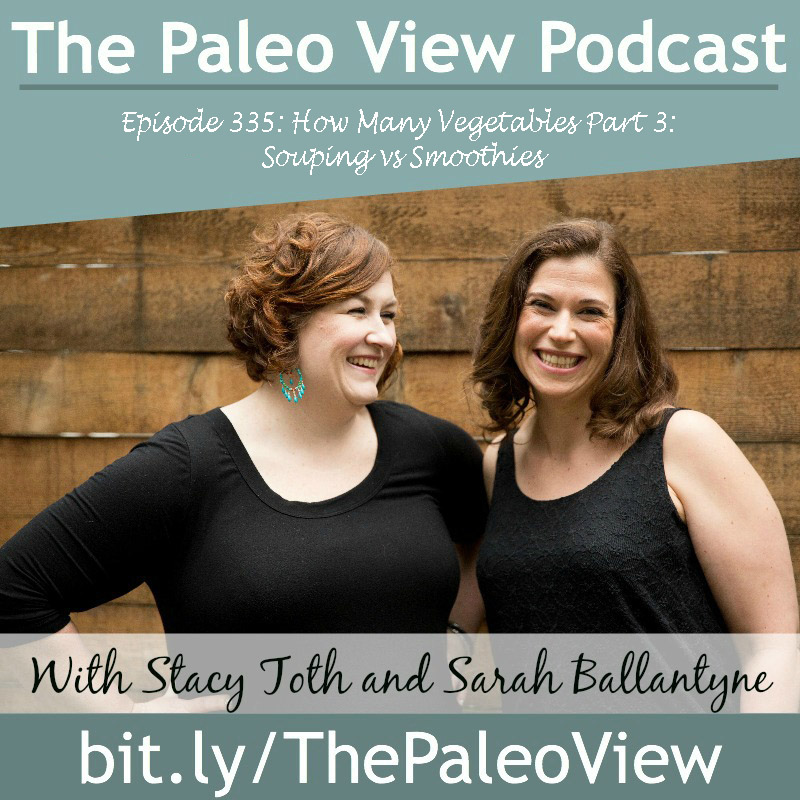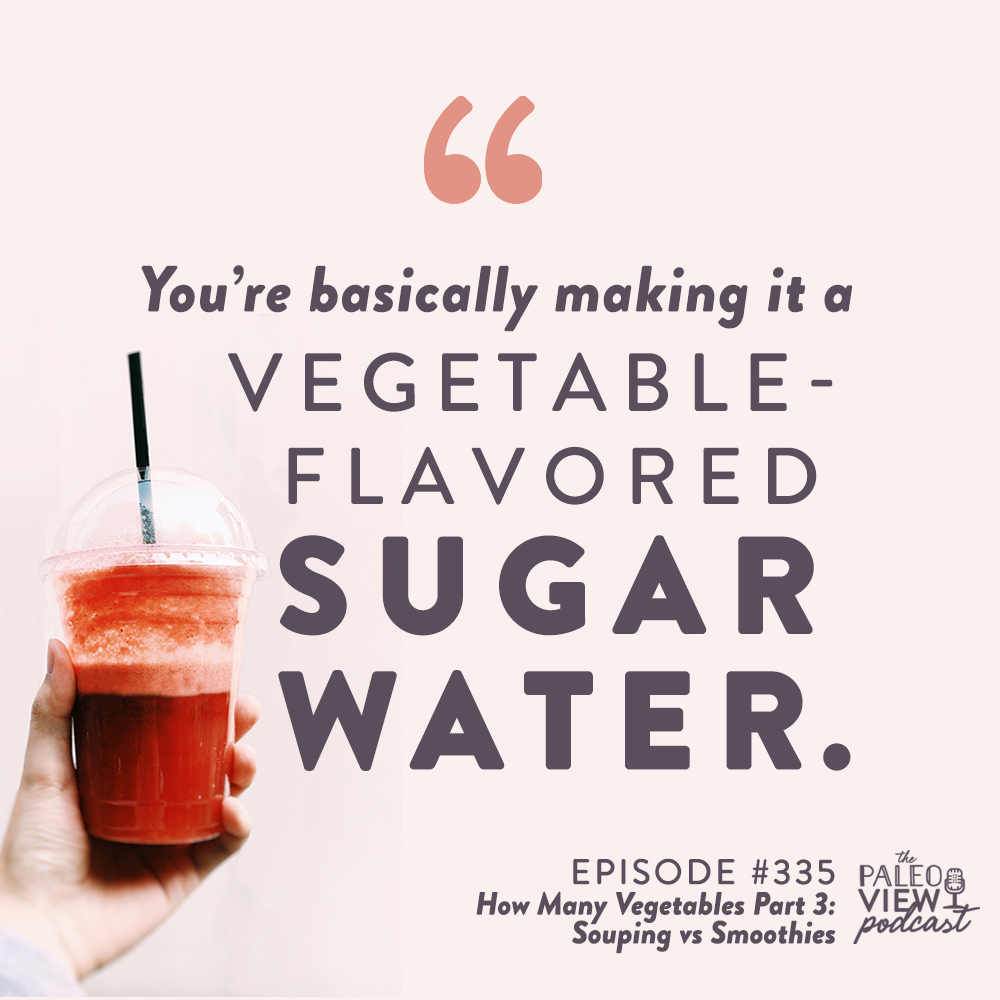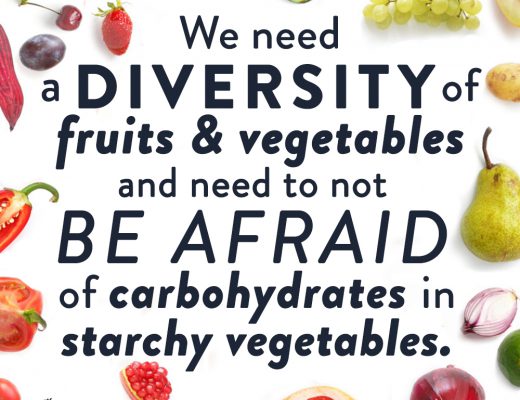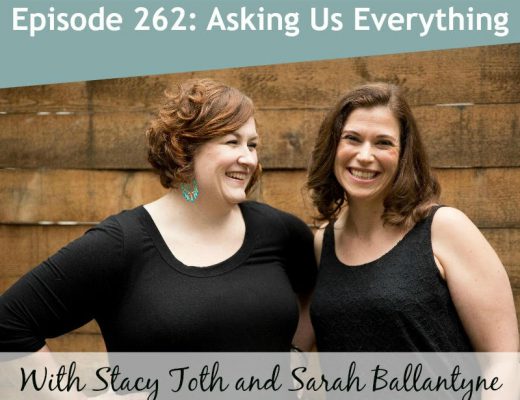
In this episode, Stacy and Sarah are back for part 3 of their popular “How Many Vegetables” series! This time they’re tackling a listener question asking whether smoothies are a beneficial way to eat vegetables, how smoothies can be upgraded for maximum nutrient-density, and if combining soups and smoothies could be the best of both worlds!
Click here to listen in iTunes
or download and listen by clicking the PodBean Player below
![]()
If you enjoy the show, please review it in iTunes!
The Paleo View (TPV), Episode 335: How Many Vegetables Part 3: Souping vs Smoothies
-
-
(0:00) Intro
-
(0:40) News and views
-
- Sarah and Stacy are back with part 3 of their ‘How Many Vegetables’ series!
- They received so many great questions about the first part and even second, that they’re back to answer your questions!
- Today specifically, they’re covering souping and smoothies
- Stacy and Sarah apologize to Christie for holding on to her great question for a year… but they’re here now to answer it!
- Sarah and Stacy are back with part 3 of their ‘How Many Vegetables’ series!
-
-
(6:03) Christie’s question
- “Thank you both for your podcast, I look forward to it every week, and it has become a huge inspiration to try to eat a more nutrient-dense diet, exercise and move more, and in general take better care of myself.
I have been drinking smoothies in the new year as a way to up my vegetable content. I know they are not typically recommended, but mine tend to be about 90% leafy greens (spinach, kale, or a blend), a small handful of frozen mango, a pinch of salt, and water. I recognize that foods that you drink tend not to be as satisfying as ones that are chewed, and, although I don’t always succeed, I try to have a combination of protein and fat on the side to make it a complete meal. I was curious about what your thoughts were about this type of smoothie (much more vegetable than fruit) as a way to increase my vegetable intake. I was curious about this especially in the context of Sarah’s post about soup. If blended soups tend to help keep one satiated longer, would a smoothie and a combination of fat/protein, or adding protein powder and/or fat to my smoothies make them a healthier option for me? How would this differ from a traditional soup? If I replaced the salt and water with a broth to make it more nutrient dense and soup like (maybe without the mango), would that have an impact? Any recommendations or thoughts you have would be greatly appreciated. Thank you both for all you do!”
- “Thank you both for your podcast, I look forward to it every week, and it has become a huge inspiration to try to eat a more nutrient-dense diet, exercise and move more, and in general take better care of myself.
-
-
-
- Stacy says that Christie is definitely on the right track!
-
(7:32) The truth about juicing
- According to Sarah, when you juice, you remove all the fiber which turns the vegetables into rapidly absorbing carbohydrates.
- Essentially, you’re making vegetable-flavored sugar water and you’re losing out on a lot of the nutrients that are bound to the fiber matrix.
- There are two main things in veggies that are really important:
- Anti-oxidant phytochemicals.
- Fiber.
- The fiber from vegetables and fruit feeds a healthier microbiome.
- This means vegetables need to be eaten in their whole form that includes the fiber.
- Stacy recommends trying the Bone Broth Smoothie recipe on her blog. It’s a great way to add some nutrient density to your smoothie.
- You don’t have to choose between ‘souping’ or smoothies – you can combine both!
- According to Sarah, when you juice, you remove all the fiber which turns the vegetables into rapidly absorbing carbohydrates.
-
(12:34) Souping
- Per calorie, any liquid calorie is less satiating. They don’t fill us up as much and we’re hungrier sooner. It doesn’t matter what the macro breakdown is.
- If you do a smoothie, it is not as filling as if you ate all the ingredients that went into that smoothie independently.
- This could be beneficial for someone who is trying to gain weight.
- Soup appears to be an exception to this. Studies show even pureed soup help us feel fuller, longer than if we ate all the components separately.
- Fully pureed keeps us fullest the longest.
- A chunky soup of broth, meat, and veggies keeps us fullest 2nd longest.
- And a meal of the separate ingredients is least satisfying compared to the above.
-
The benefits of soup:
- It digests slower
- It helps us feel fuller longer
- Though it absorbs quickly, it causes a release of satiety hormones, which has an appetite suppressing effect.
- Faster nutrient absorption
- Though there isn’t a study for this, Sarah suspects that eating the hot liquid calories has something to do with it.
- If you’re looking to reduce calories and lose weight, soups are more satisfying, so they could be a great way to go.
- Stacy notes that some people prefer juicing because eating a full meal while sitting at an office job for 8 hours a day makes them feel sluggish. She says it’s important to match your food to your energy output.
- Sarah jumps into to say that this could have something to do with cortisol release after a meal, especially depending on how stressed you are during the day.
- Sarah thinks soup would be a good option in Stacy’s sister’s circumstance because they’re easily digestible.
- Fatigue could also be a sign of a food allergy.
-
(24:35) Raw vs cooked fiber
- When you make soup, you’re cooking the ingredients, versus a smoothie, which contains raw ingredients.
- This changes how easy the nutrients are to absorb and how they affect the gut microbiome.
- Cooked foods are more easily digestible, which provides more energy.
- We also absorb more nutrients from cooked food.
- Depending on whether a food is raw or cooked, it will support the growth of different gut bacteria.
- However, raw ingredients can have beneficial effects on our prebiotic bacteria.
- So it’s important to eat both raw and cooked foods because it supports a diverse gut microbiome! Sarah suggests cycling between raw, slightly cooked, and very cooked vegetables.
-
(29:24) Particle size matters
- When you put soup or smoothie into a blender, you’re breaking those foods up into a size that’s even smaller than we can chew, which changes how this food behaves in our digestive tract.
- People with gut issues do really well with soups and smoothies because it’s much easier to digest.
- This also makes the fibers more easily fermentable in your gut.
- It’s important to note, this isn’t always a good thing. Because it’s so easily fermentable, there might not be enough of that food left to ferment in the large intestine.
- This is an argument for complete meals and mixing it up! Include a mix of smoothies, pureed soups, chunky soups in your diet.
- Sarah goes on a tangent about scientific studies and butter.
-
(42:16) The wrap-up
- Stacy concludes she’s going to continue eating soup.
- Though if you love green juice, you don’t have to cut them out entirely! Drinking in moderation and drinking it alongside healthy fat and protein will help slow down the absorption.
- Stacy and Sarah do not recommend going on a month-long juice fast.
- Stacy remembers when her mom when on a diet that involved juicing and eating hot dogs and she thinks that’s when her mother’s health began to decline.
- Every study Sarah and Stacy have ever found confirms that vegetables improve our health. So why mess with a good thing?
- Thank you for tolerating all of our tangents today.
- Stacy and Sarah hope you’re having a great January full of feel-good, healthy habits!
-
- Get your questions in! We want to hear from you! And there’s no end to questions we can answer and topics we can address!
- Engage on social media! That’s how we get feedback!
- Thank you for listening.
Resources
TPV Podcast, Episode 281: How Many Vegetables?!
TPV Podcast, Episode 282: Joint Health, Arthritis, and Why We Eat All the Soup, Broth, and Collagen
TPV Podcast, Episode 286: How Many Vegetables Part 2: Lectins & Oxalates
Broth Smoothie Recipe + Real Life Meal Planning: What We Ate Wednesday January 20





